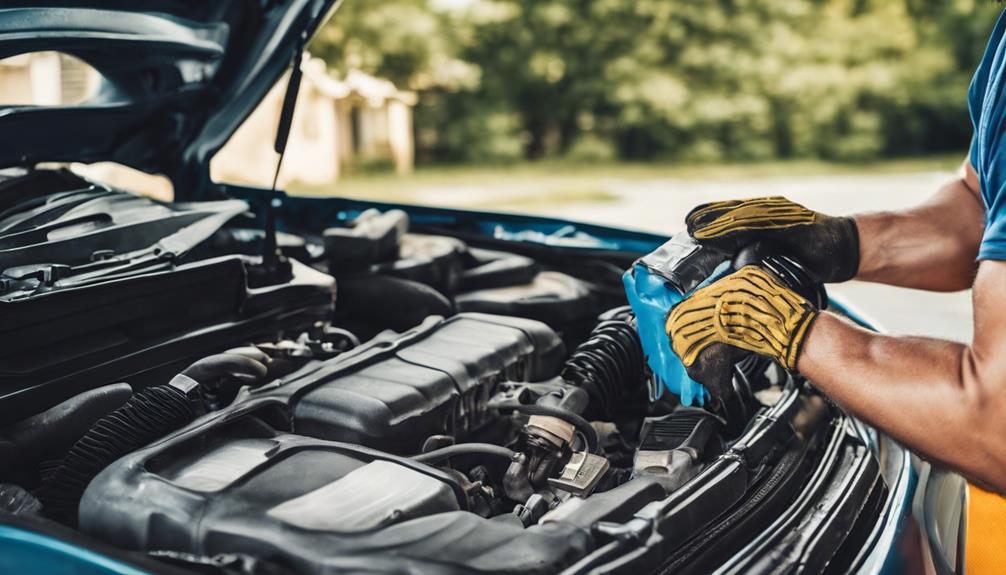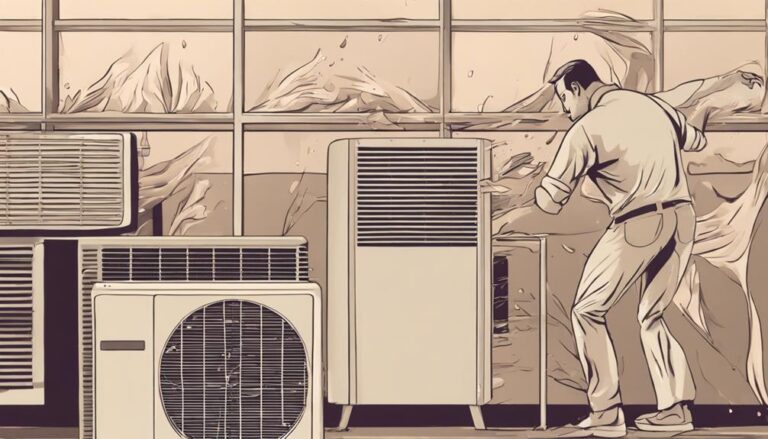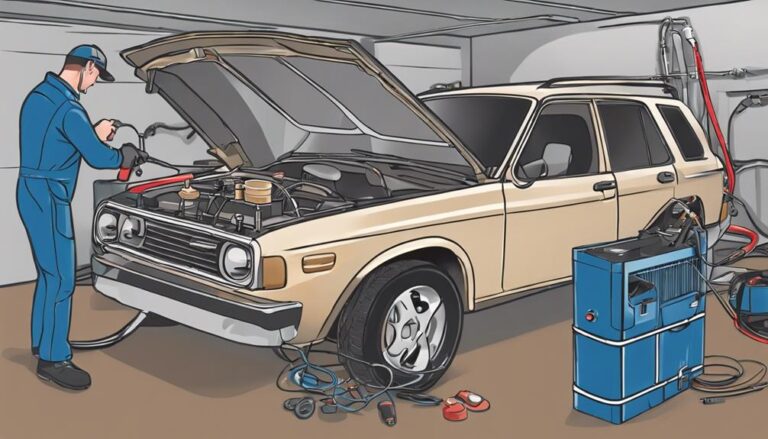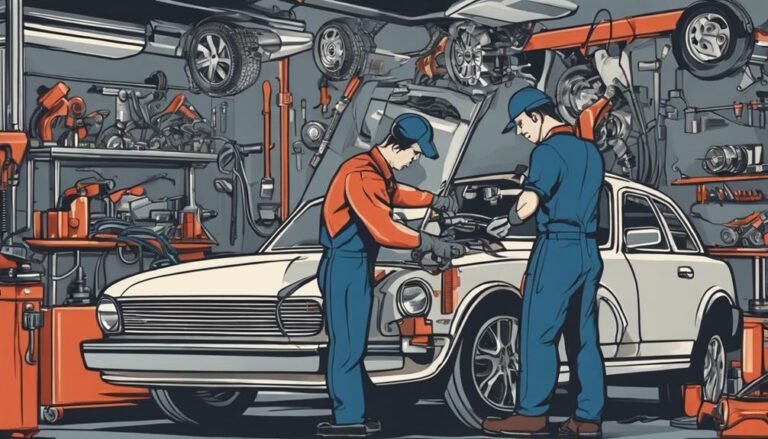Top 10 Tips for Emergency Car AC Repairs
When the scorching sun beats down, and your car's AC falters, it can feel like being stranded in a desert.
From checking refrigerant levels to diagnosing compressor issues, mastering emergency car AC repairs is a must.
Dive into these expert tips to navigate the sweltering roads with ease and keep your cool on the go.
Key Takeaways
- Regular maintenance prevents costly repairs and ensures optimal AC performance.
- Watch for warning signs like weak airflow, strange noises, and temperature struggles.
- Detect leaks promptly to address issues and maintain proper refrigerant levels.
- Inspect and maintain filters, belts, and hoses to prevent breakdowns and ensure efficient AC operation.
Importance of Regular Maintenance
Regular maintenance of your car's air conditioning system is crucial for preventing costly repairs and ensuring optimal performance. By adhering to routine maintenance schedules, you can reap a multitude of maintenance benefits that go beyond just avoiding pricey repairs.
Preventative measures such as regular servicing not only help in addressing issues early on but also contribute to the efficient cooling and optimal functionality of the AC system. In essence, proper maintenance extends the lifespan of your AC system, providing improved driving comfort and peace of mind.
Neglecting maintenance can result in reduced cooling capacity, diminished performance, and even potential breakdowns, all of which can disrupt your driving experience. Through professional maintenance, hidden issues can be identified and resolved promptly, ensuring that your AC system operates smoothly even during emergencies. Embracing regular maintenance practices isn't only a wise investment in the longevity of your car's AC system but also in the overall reliability and comfort of your vehicle.
Signs of AC System Failure
If you notice weak airflow, strange noises, or unpleasant odors coming from your car's AC system, these could point towards underlying issues that require immediate attention.
To ensure the proper functioning of your AC system, it's crucial to conduct a thorough diagnostic check when you encounter any warning signs.
Taking prompt action and investigating the root cause of these symptoms will help prevent further damage and keep your car's AC running efficiently.
Warning Signs to Watch
Keeping a vigilant eye out for warning signs can help you identify potential AC system failures before they escalate.
- Weak airflow or hot air from vents
- Unusual noises like squealing or grinding
- Foul odors, such as musty smells
- Struggles to reach desired temperature
Early detection and maintenance are key to preventing major AC system failures. Troubleshooting these warning signs promptly can save you from costly repairs down the road.
If you notice any of these signs, it's essential to address them promptly to ensure your AC system operates efficiently. Regular maintenance checks and swift action can help keep your car's AC system running smoothly, especially during hot summer days.
Immediate AC System Check
When conducting an immediate AC system check for signs of potential failure, prioritize examining weak airflow, unusual noises, foul odors, temperature inconsistencies, and any visible leaks or moisture. Rapid response and urgent evaluation are crucial to prevent further damage. Here is a concise table to summarize the key signs to look out for:
| Signs of AC System Failure |
|---|
| Weak Airflow |
| Unusual Noises |
| Foul Odors |
| Temperature Inconsistencies |
| Visible Leaks or Moisture |
Diagnostic Steps to Take
To diagnose signs of AC system failure effectively, begin by systematically inspecting each potential issue indicated by weak airflow, unusual noises, foul odors, temperature inconsistencies, and visible leaks or moisture.
- Troubleshooting Techniques: Check for weak airflow to address clogged cabin air filters or failing blower motors.
- Emergency Solutions: Address unusual noises like squealing or grinding by inspecting the compressor and other components.
- Quick Fixes: Combat foul odors by investigating mold or bacteria growth within the system.
- Temporary Solutions: Investigate refrigerant leaks or compressor problems if the A/C fails to reach desired temperatures.
Check for Leaks
Inspect A/C components for oil stains or wet spots to identify potential refrigerant leaks. Utilize a UV dye test kit for effective leak detection by injecting dye into the A/C system and employing a UV light to pinpoint any leaks accurately.
Additionally, check the A/C system pressure using a pressure gauge to assess if there are any leaks impacting refrigerant levels. Ensure to meticulously examine the A/C hoses, connections, and fittings for any indications of wear, cracks, or damage that might result in leaks.
Promptly addressing any identified leaks is crucial not only to prevent further harm to the A/C system but also to uphold optimal cooling efficiency. Regular A/C system maintenance plays a vital role in leak prevention, thereby safeguarding the system's functionality.
DIY Troubleshooting Steps
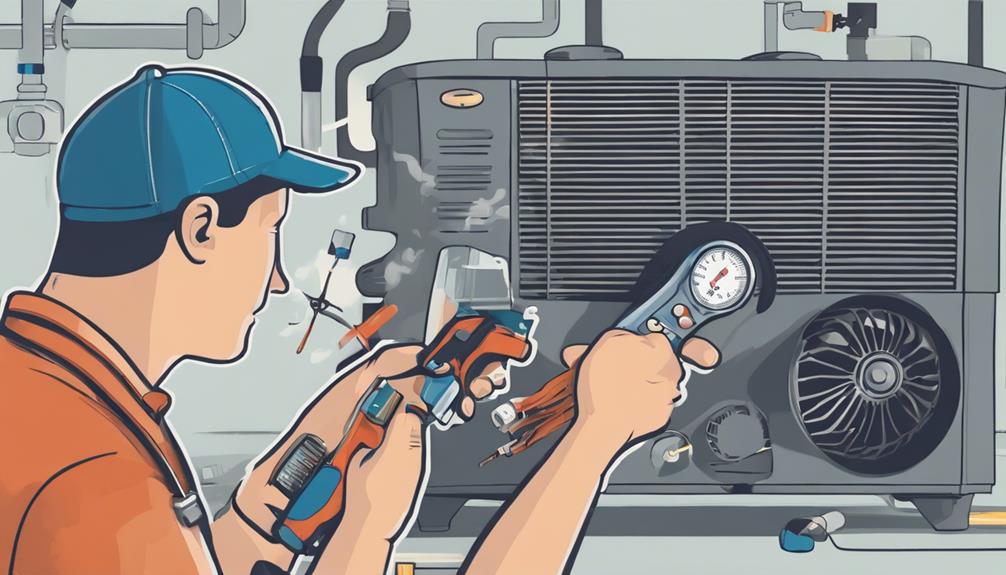
For effective troubleshooting of your car's A/C system, start by visually inspecting all components for any signs of damage or irregularities. This initial step can help you identify potential issues before diving deeper into the system diagnosis.
Here are some troubleshooting techniques to guide you:
- Check for visible leaks or moisture: Look around A/C components for any signs of leaks, which could indicate a problem with the system.
- Inspect A/C belts: Ensure that the belts are in good condition as damaged belts can lead to malfunctions in the A/C system.
- Test the A/C compressor: Verify if the compressor is engaging properly and operating efficiently to guarantee effective cooling.
- Verify the condenser fan: Check if the condenser fan is functioning correctly to maintain optimal airflow for cooling performance.
Understanding Refrigerant Levels
You need to grasp the significance of maintaining proper refrigerant levels in your car's AC system. Low refrigerant levels could result in inadequate cooling and potential AC compressor damage.
Understanding the signs of low refrigerant and knowing how to check the levels are crucial for optimal AC performance.
Refrigerant Importance
Understanding the importance of refrigerant levels in your car's AC system is crucial for maintaining efficient cooling performance and preventing potential damage. When it comes to refrigerant maintenance, there are key points to keep in mind:
- Essential Component: Refrigerant is vital for absorbing and releasing heat to cool the cabin air.
- Efficient Cooling: Proper refrigerant levels are necessary for optimal cooling efficiency.
- Avoid Damage: Low refrigerant levels can lead to decreased cooling capacity and potential compressor damage.
- Prevent Overcharging: Overfilling the system with refrigerant can result in poor cooling performance and compressor issues.
Regularly checking and maintaining the refrigerant level will ensure that your AC system functions effectively and lasts longer.
Signs of Low Refrigerant
Monitoring the signs of low refrigerant levels in your car's AC system is crucial for ensuring efficient cooling performance and preventing potential damage.
Signs of low refrigerant include warm air blowing from vents, reduced cooling capacity, and increased humidity in the car. If you suspect low refrigerant levels, it's essential to address the issue promptly.
One common cause is a refrigerant leak, which can lead to decreased cooling efficiency and potential system malfunctions. Detecting and repairing leaks promptly is vital for maintaining optimal AC function.
Understanding the refrigerant recharge process is crucial for restoring proper levels and ensuring your car's AC system operates at its best.
Regularly monitoring and addressing refrigerant levels will help keep your AC system in top condition.
Checking Refrigerant Levels
If your car's AC system is showing signs of low refrigerant, the next step is to check the refrigerant levels to ensure optimal cooling performance and prevent potential damage. Understanding refrigerant levels is crucial for DIY maintenance.
Here are some key points to consider:
- Regular checks maintain efficient cooling.
- Low levels can cause poor cooling and system damage.
- R-134a is the most common refrigerant used.
- Specialized equipment like a manifold gauge set is needed for checking.
Proper refrigerant levels are essential for the AC system's longevity and performance. Stay informed and take the necessary steps to keep your car's AC running smoothly.
Cleaning or Replacing Filters
To maintain optimal performance and ensure proper functioning of your car's AC system, regularly cleaning or replacing the air filters is essential. Clean filters improve airflow, prevent dust and debris from circulating, and maintain optimal cooling performance while preventing strain on AC components. Neglecting filter maintenance can lead to reduced cooling capacity, increased energy consumption, and potential damage to the AC system. It is crucial to check and replace filters according to the manufacturer's recommendations to uphold the efficiency of the AC system and maintain good air quality inside your vehicle.
| Filter Maintenance Tips & Benefits | Filter Replacement Schedule & Importance |
|---|---|
| – Clean or replace filters every 12,000-15,000 miles | – Follow manufacturer's guidelines for replacement |
| – Use high-quality filters for better filtration | – Regularly inspect filters for dirt and clogs |
| – Improve airflow and prevent odors | – Prevent reduced cooling efficiency |
| – Ensure proper functioning of the AC system | – Maintain good air quality inside the vehicle |
Inspecting Belts and Hoses
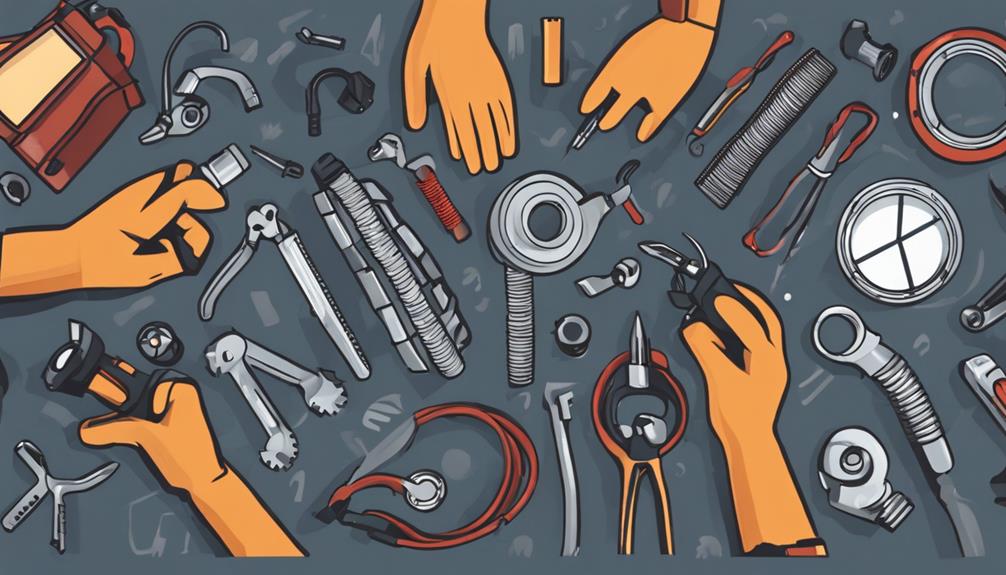
When inspecting belts and hoses, look for cracks, fraying, or signs of wear to prevent potential belt failure.
Check hoses for leaks, bulges, or soft spots that could indicate underlying issues.
Replace any worn or damaged belts and hoses promptly to avoid sudden AC system breakdowns.
Visual Inspection for Wear
Inspect the belts and hoses of your car's AC system regularly for signs of wear, such as cracks or fraying, to prevent potential failures. Checking for wear involves a thorough visual inspection to catch problems early.
Here are key visual inspection techniques to help you assess the condition of your belts and hoses:
- Look for cracks, splits, or worn areas on the belts.
- Check for any fraying or damage along the edges of the belts.
- Inspect hoses for signs of bulging, soft spots, or leaks.
- Ensure proper alignment and tension of the belts to maintain efficient operation.
Regularly monitoring these components will help you identify issues before they escalate, saving you from costly repairs down the road.
Checking for Cracks
Regularly checking for cracks on your car's AC belts and hoses is crucial to preventing potential failures and maintaining optimal system performance. Belt longevity and hose maintenance are essential aspects of ensuring your car's AC system operates efficiently. Inspect the belts for any signs of cracks, fraying, or wear as these can lead to belt failure and impact the performance of the AC compressor. Similarly, check the hoses for cracks, leaks, or bulges that could result in refrigerant leaks or damage to the system. Visible indicators like glazing, cracking, or soft spots on belts and hoses should not be overlooked. Early identification of issues through thorough inspection can save you from expensive repairs down the road.
| Importance of Belt Longevity and Hose Maintenance |
|---|
| Prevents belt failure and AC compressor issues |
| Avoids refrigerant leaks and system damage |
| Early detection saves on costly repairs |
Assessing Tension Levels
To ensure optimal performance of your car's AC system, it's essential to regularly evaluate the tension levels of belts and hoses, checking for signs of wear or damage that could compromise functionality.
- Inspect belts for cracks, fraying, or signs of wear to ensure proper tension and grip.
- Check hoses for leaks, bulges, or damage that may lead to loss of refrigerant or compressor malfunction.
- Tighten or replace any loose or damaged belts to prevent slipping and ensure efficient operation of the AC system.
- Replace worn-out hoses to maintain proper refrigerant flow and prevent potential system failure.
Regularly inspecting belts and hoses as part of routine maintenance will help you avoid sudden AC breakdowns during emergencies. Remember, timely tension adjustment and belt maintenance are key to keeping your car's AC running smoothly.
Electrical Components Check
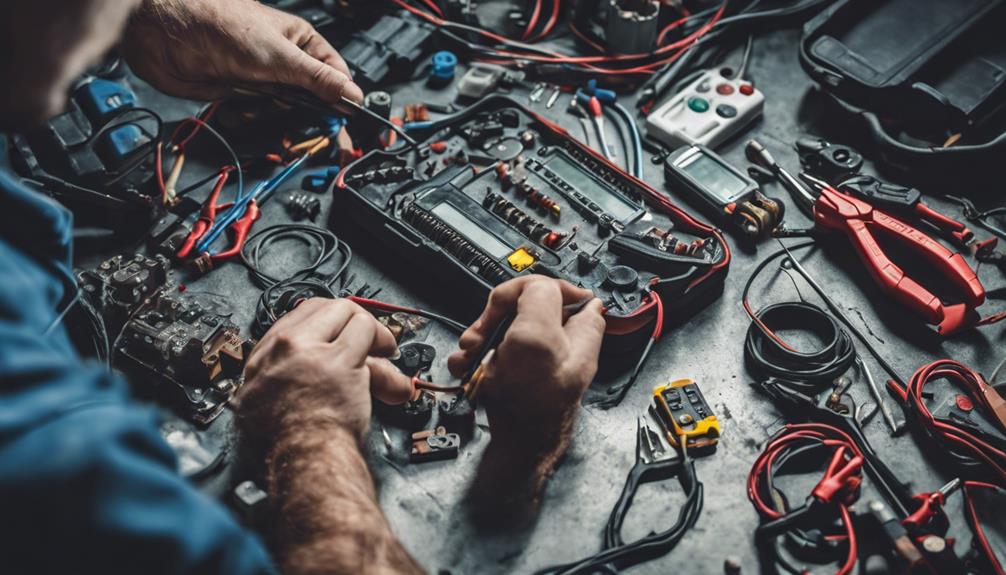
Begin by checking the car's fuse panel to locate related fuses like bcm, climate control, and blower motor for potential issues. Next, use a test light to examine the functionality of the compressor clutch coil or AC relay to detect any short circuits. Additionally, test the AC relay and pressure sensor to ensure the proper activation of the compressor in the AC system. Inspect the climate control computer and conduct voltage tests if needed to diagnose any electrical component problems. Regularly maintaining and inspecting these electrical components is crucial to prevent malfunctions and ensure the efficient operation of your car's AC system.
| Electrical Components Check | Tips |
|---|---|
| Inspect Fuse Panel | Locate bcm, climate control, blower motor fuses. |
| Test Compressor Components | Check compressor clutch coil, AC relay for short circuits. |
| Check AC Relay and Sensor | Ensure proper compressor activation. |
| Voltage Testing | Examine climate control computer; conduct voltage tests if necessary. |
Professional Repair Vs. DIY
Consider the complexity of the AC issue and your level of comfort with automotive repairs when deciding between professional repair services and DIY methods for your car's AC system. When weighing your options, keep in mind the following:
- Repair Cost: Professional repairs can be more expensive due to labor costs and specialized tools required for accurate diagnoses.
- Time Commitment: DIY repairs often take more time as you may need to research the issue, gather tools, and potentially make multiple attempts to fix the problem.
- Expertise: Professional repair services have the advantage of trained technicians who can quickly identify and resolve complex AC issues.
- Warranty Consideration: Professional repairs help maintain the warranty validity of your car's AC system, while DIY attempts may void warranties and lead to costly damages if done incorrectly.
Your decision should be based on the severity of the AC problem, your budget, and your confidence in tackling automotive repairs.
Emergency Cooling Tips

When facing an emergency situation with your car's AC system, practical cooling solutions can help manage discomfort and prevent overheating. In such instances, consider rolling down your windows and utilizing the fan to circulate air within the vehicle before resorting to the AC, especially if it's not functioning.
Parking in a shaded area can also aid in preventing the car from overheating further. Keeping portable solutions like a battery-operated fan or mini cooler in your emergency car kit can provide temporary relief. Additionally, having portable ice packs or wet towels to apply on your neck or wrists can help cool down in case of AC failure.
It's crucial to stay hydrated and avoid direct sunlight to better manage heat discomfort while waiting for AC repairs. These cooling strategies and alternatives can assist in maintaining a tolerable environment within your vehicle during unexpected AC malfunctions.
Frequently Asked Questions
How Do You Keep Your Car Cool When the AC Is Broken?
To keep your car cool when the AC is broken, use cooling strategies like solar-powered fans and cold packs. Prioritize interior comfort by parking in shaded areas and wearing breathable clothing. Maintain your car to ensure summer driving comfort.
What to Do When Car AC Stops Working?
When your car AC stops working, troubleshoot by checking power supply, refrigerant levels, for leaks, and compressor clutch engagement. If issues persist, seek professional help for emergency cooling solutions and accurate diagnosis and repair.
What Can I Put in My Car for AC to Work?
To make your car's AC work in a pinch, try using a portable fan or ice pack to cool down. Window shades can also help block out heat. Consider adding an air freshener for a pleasant driving experience.
What Kills Car AC Compressor?
Neglecting compressor maintenance is like serving a death sentence for your car AC. Common issues such as low refrigerant levels, electrical faults, and contaminants can mercilessly kill your compressor. Regular care is your AC's lifeline.
Conclusion
In conclusion, prioritizing regular maintenance and following the top 10 tips for emergency car AC repairs can ensure optimal cooling efficiency and prevent costly repairs.
By checking refrigerant levels, inspecting belts and hoses, and addressing any signs of system failure promptly, you can keep your car's AC system running smoothly.
Remember, a well-maintained AC system not only provides comfort but also contributes to a hygienic and safe driving environment.
Stay cool on the road!

